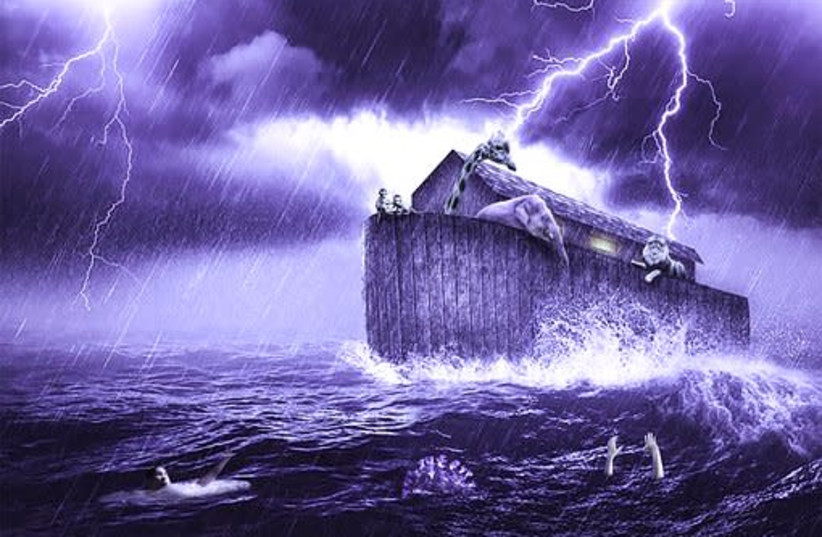Birds play an important part in the story of Noah.
As the flood waters recede, Noah opens the window of the ark “and he sent forth the raven, which went forth to and fro, until the waters were dried up from off the Earth” (Genesis 8:7). He also sends forth the dove – three times. The first time she returns, having found “no rest for the sole of her foot” (Genesis 8:9); next, she returns with an olive leaf in her mouth (Genesis 8:11); and the third time, she does not return at all.
Why did Noah send the raven first? One midrash refers to the verse “He sent darkness, and it was dark” (Psalms 105:28) and associates the raven’s dark hue with the darkness of a post-flood, seemingly hopeless, world. Ravens are often associated with desolation.
When Isaiah describes the total destruction that is destined to come upon “all the nations,” he says (Isaiah 34:11): “It will be the inheritance of wild animals of the night; the owl and the raven will dwell in it.”
The ravens, the flood, and destruction
In his essay “The Raven – Nevermore?” (aish.com), Rabbi Ari Kahn writes: “Noach sees the raven as a symbol of the darkness and cruelty that surround him and that have led to the massive, nearly total destruction of the world and its inhabitants. Noach believes that God has abandoned the world. God’s kindness has disappeared and the attribute of Elokim [the Divine name associated with strictness] reigns.”

Thus Noah’s first emissary is “a symbol of cruelty and darkness. Only later does he explore the possibility of kindness, loyalty and peace” and sends forth the dove, which “represents God’s merciful and kind attributes.”
Rabbi Kahn points out that the Hebrew word for dove (yonah) “contains three of the four letters of the Divine name denoting omnipresence. Noach rejects the raven, casts it away, and identifies with the dove that he sends “me’ito” – of or from himself” (Genesis 8:8).
In the Talmud’s elaboration on Noah’s story, we find yet another bird – the phoenix. According to Sanhedrin 108b, Noah found the phoenix lying in its niche in the ark and asked it, “Don’t you need food?” The phoenix replied, “I saw that you were busy and didn’t want to bother you with feeding me too.”
Noah then said, “May it be the will of God that you never die!” Hence the phoenix is granted the gift of eternal rebirth. (The Midrash, however, states that the phoenix is immortal because it was the only creature that refused to eat of the Tree of Knowledge, according to Bereshit Rabbah 18:5.)
The phoenix is a symbol of hope, of regeneration after destruction. To the Talmudic sages, who introduced us to the phoenix, the fabulous bird perhaps represented the hope of rebirth after the destruction of the Temples. It is a fitting symbol of the Jewish people, who have arisen from so many destructions.
THE PHOENIX, under the name chol, also appears in one of the speeches of Job (28:18), who was to rise from the ashes and start life anew. In the first years after the fire that destroyed the studio of my husband, Yoram Raanan, and most of his life’s work, the phoenix appeared in a number of his new paintings. Noah and the Birds began, like many of Raanan’s paintings, with the artist throwing watery acrylic paint on the canvas.
Gradually from the watery chaos, shapes and meaning emerged, until the painting, as Raanan says, “has graphic presence. It catches the eye, but it has a subtle depth; however, it takes effort and time to really look at it. Invest to look and enter a new unexplored world…”
At the bottom of the painting, a wavy blue area suggests the receding flood water. A deep-black raven shape contrasts with the luminosity of the background that is suffused with a bright yellow light, like the sun coming out after the storm, the beginning of a new world.
Above the raven-like shape rises another shape in soft shades of brown, suggestive of a human silhouette that appears humble and self-effacing. To the right of the raven and the man, we see a standing winged shape – the phoenix, whose wings are also rays of light.
The painting has a three-dimensional aspect that also emerged from Raanan’s process. The paint was actual puddles of color. To keep it from running, Raanan took rags to soak up the paint and left them there to dry. The rags were so full of acrylic binder that they stuck to the canvas. They looked to him like birds, so he shaped them a little and added more rags. The one at the upper right, especially, resembles the dove sent forth.
It is a turbulent painting, dominated at first glance by the ominous shape of the raven. Yet as the eye dwells on the painting, one perceives symbols of hope and becomes aware of the warm luminosity permeating the whole. A new world emerges from chaos.
So may it be with us. ■
Meira Raanan is the author of the Art of Revelation: A Visual Encounter with the Jewish Bible, a commentary on the paintings by her husband, Yoram Raanan. She also teaches Jewish meditation. Esther Cameron is a poet, scholar, and essayist living in Jerusalem. She is editor-in-chief of The Deronda Review.
